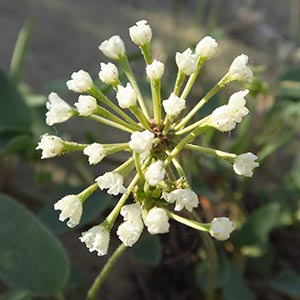Abronia mellifera
Abronia angustifolia
honey scented sand-verbena, white sand-verbena
purple sand verbena
decumbent to ascending, much branched, elongate, glabrous or glandular-pubescent.
decumbent to ascending, much branched, elongate, often reddish, glandular-pubescent, viscid.
petiole 1–6 cm;
blade ovate to lance-elliptic, 1–6 × 0.5–4 cm, margins entire to sinuate and ± undulate, surfaces glabrous or glandular-pubescent.
petiole 1–7 cm;
blade ovate-oblong to elliptic, 1–5.5 × 0.7–3 cm, margins entire to sinuate, often ± undulate, infrequently shallowly lobed, surfaces viscid-pubescent.
peduncle longer than subtending petiole;
bracts lanceolate to obovate, 5–12 × 1–5 mm, papery, glabrate to glandular-pubescent;
flowers 25–60.
peduncle longer than subtending petiole;
bracts lanceolate to oblong-lanceolate, 5–10 × 1–3 mm, papery, glandular-pubescent;
flowers 10–30.
tube pale rose proximally to greenish distally, 15–25 mm, limb white, 7–12 mm diam.
tube pink, 10–20 mm, limb bright magenta to pale pink, infrequently pale rose, 6–8 mm diam.
winged, broadly obdeltate or cordate in profile, 6–10 × 4–10 mm, thin, usually coriaceous, rarely indurate, base attenuate, apex prominently beaked;
wings (2–)5 (when 2, folded to form single deep groove), without dilations, broad, thin, without cavities.
broadly obdeltate in profile, 5–10 × 4–8 mm, scarious, apex narrowly tapered to a prominent beak;
wings 5, extending to or slightly beyond base of beak, truncate, with conspicuous dilations, cavities extending throughout.
Abronia mellifera
Abronia angustifolia
Plants on gypsum flats and knolls of White Sands, New Mexico, are perennial, but may flower in their first season.
(Discussion copyrighted by Flora of North America; reprinted with permission.)


